Installing MySQL 5.0.
Information
none
Operating system used
Windows XP Home Edition Version 5.1 SP 2
Software prerequisites
none
Procedure
- If you have installed "ZoneAlarm Free Firewall" you MUST completely
remove it from your computer.
If you only shutdown ZoneAlarm you will still have a problem later on.
After MySQL is installed you can reinstall "ZoneAlarm Free Firewall".
- If you have previously installed MySQL 4.018 and you want to install
a new MySQL version do the following (for an upgrade read the documentation):
-
WARNING: THE FOLLOWING STEPS WILL COMPLETE REMOVE THE OLD MySQL INSTALLATION AND
DATABASES. BE SURE IF YOU WANT TO DO THIS.
- Stop the current server.
Open a dos window and type: net stop mysql
- Remove the previously installed mysql service.
C:\..\mysql\bin>mysqld-nt --remove
- Remove the old MySQL version:
Start | Settings | Configuration Screen | Software | Select "MySQL Servers and Clients 4.0.18"| Remove
- Remove the old C:\..\mysql\ directory.
- Go to your Windows Firewall settings:
- Start | Settings | Configuration Screen | Windows Firewall
- Select Tab Exceptions (Dutch: Uitzonderingen)
- If found, select service "MySQL Server" and press the Delete (Dutch: Verwijderen) button.
Make sure there are no other services using port 3306.
Note: During the MySQL installation, the "MySQL Server" service will be added as a Firewall exception.
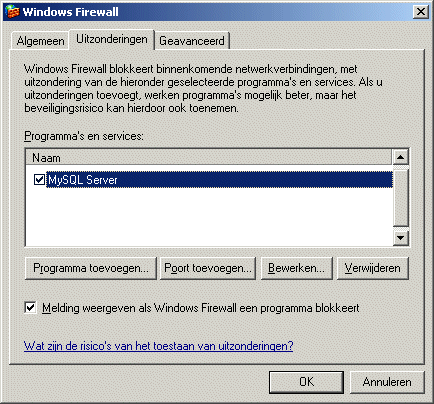
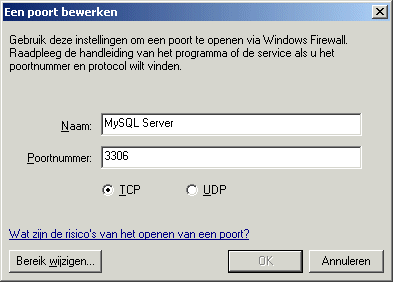
- Restart your computer.
- Download and unzip mysql-5.0.51a-win32.zip (Windows ZIP/Setup.EXE)
- Execute Setup.exe to install MySQL Servers and Clients on your computer and press Next button.
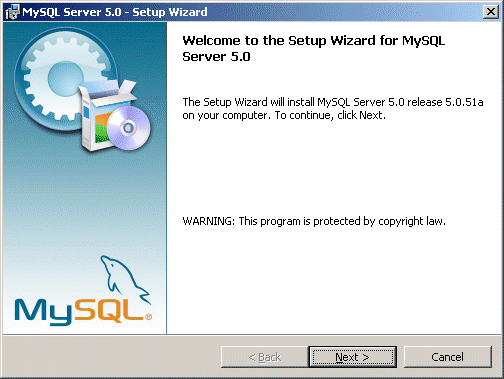
- Select setup type "Custom" and press Next button.
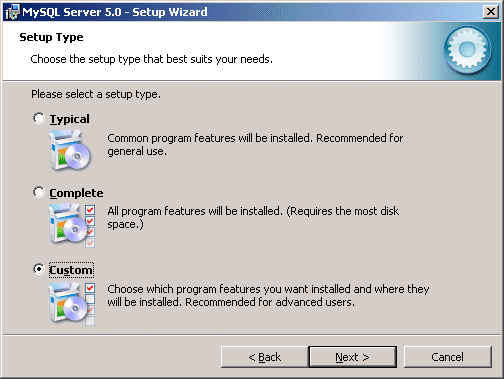
- Change the MySQL destination folder, e.g.: C:\Tools\mysql and press Next button.
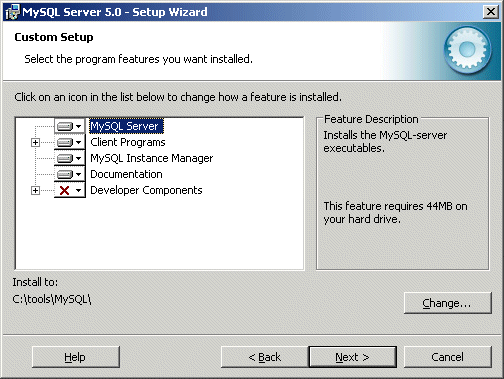
- The wizard is ready to begin installation, press Install button.
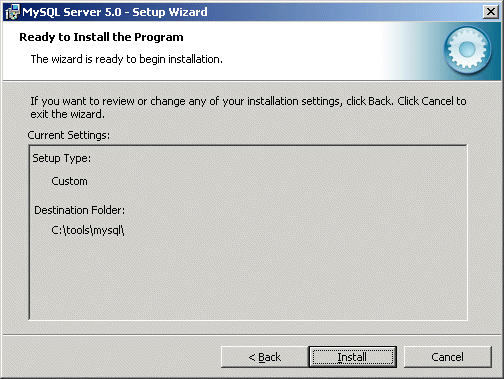
- When the wizard is finished, press the Next button twice.
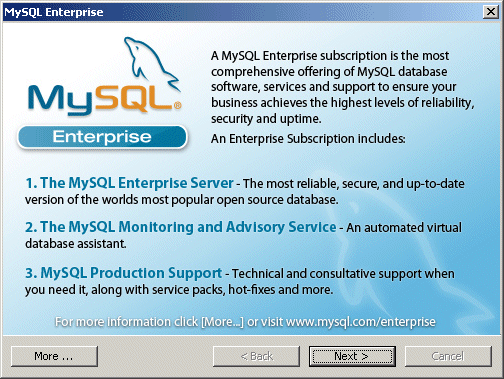
- Check the box "Configure the MySQL Server now" and press the Finish button.
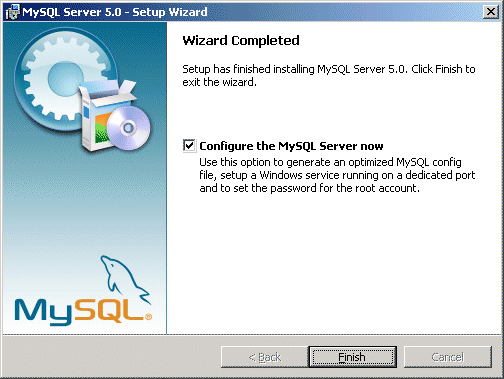
- The Configuration Wizard screen is displayed, press the Next button.
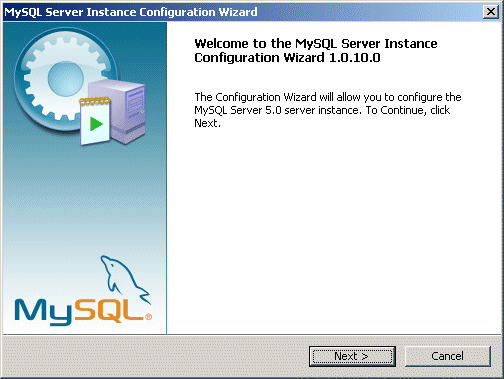
- Select "Detailed Configuration" and press the Next button.
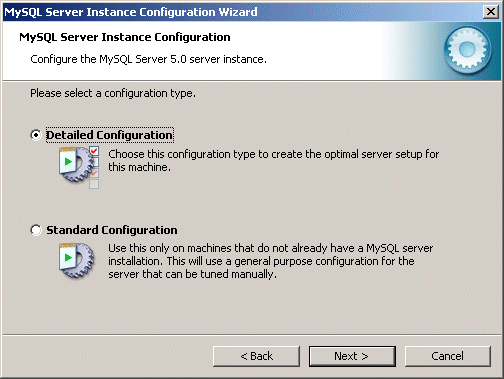
- Select "Developer Machine" and press the Next button.
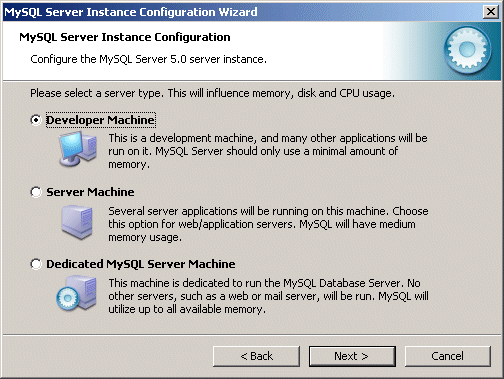
- Select "Mutifunctional Database" and press the Next button.

- Select the drive and directory where the InnoDB tablespace should be placed and press the Next button.
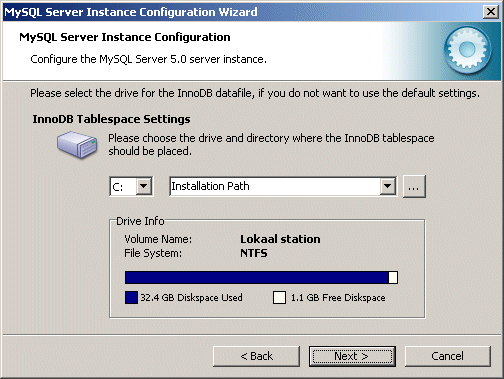
- Select the number of concurrent connections and press the Next button.
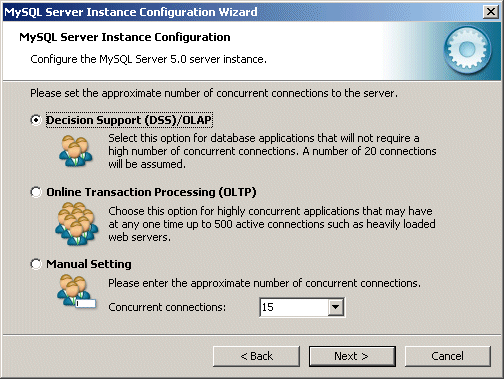
- Set the networking options and press the Next button.
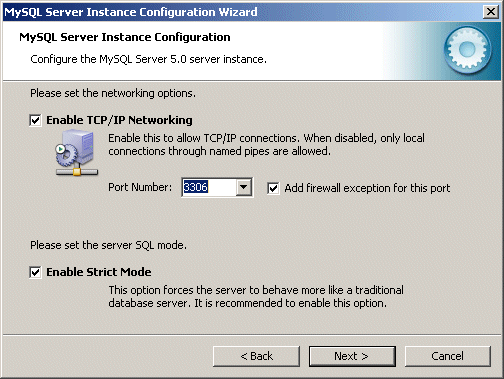
- Select option "Best Support For Multilingualism", this option makes UTF8
the default character set.
Press the Next button.
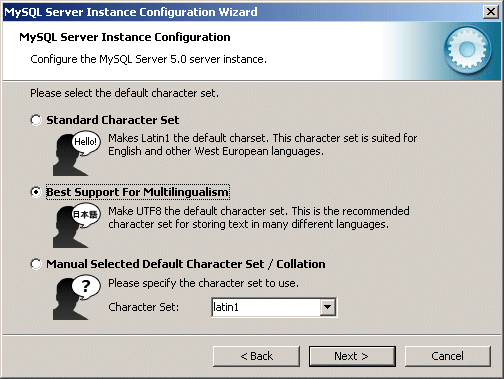
- Enable both checkboxes and press the Next button.
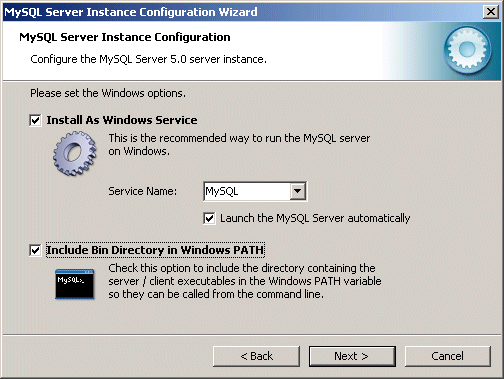
- Set the root password (e.g.: mysecret) for your MySQL server and press the Next button.
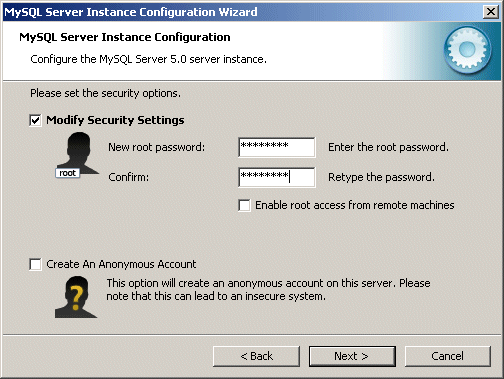
- Press the Execute button to start the configuration.
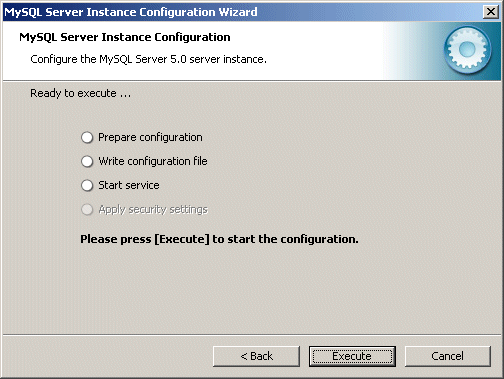
- If your firewall blocks port 3306, you will see the message below.
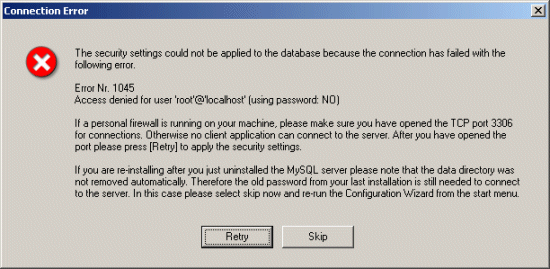
To solve this problem, do the following:
- Please check your firewall settings and unblock port 3306.
- Select Start | Programs | MySQL | MySQL Server 5.0 | MySQL Server Instance Config Wizard
- After the "MySQL Server Instance Config Wizard" welcome screen is displayed, press the Next button.
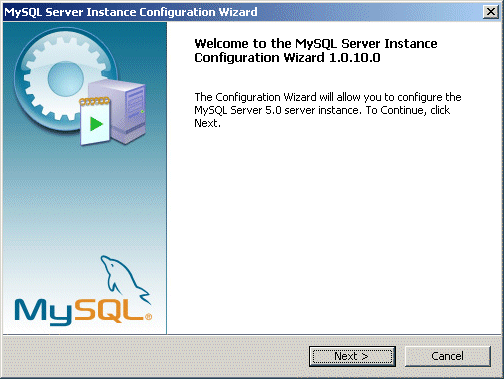
- Select "Remove Instance" and press the Next button.

- Follow again step 13 till 22.
If all went well, press the Finish button to close the wizard.
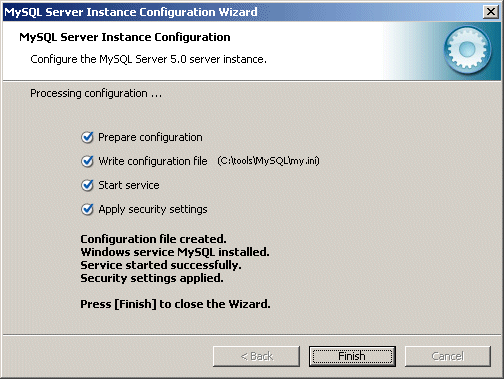
- After installation you can find the MySQL 5.0 Reference Manual in C:\Tools\mysql\Docs\
The data directory can be found in C:\Tools\mysql\data.
- To check if the MySQL server is running, type:
C:\Tools\mysql\bin>mysql -uroot -pmysecret test
You should see:
Welcome to the MySQL monitor. Commands end with ; or \g.
Your MySQL connection id is 34
Server version: 5.0.51a-community-nt MySQL Community Edition (GPL)
Type 'help;' or '\h' for help. Type '\c' to clear the buffer.
- To display more information, type:
mysql>status
You should see:
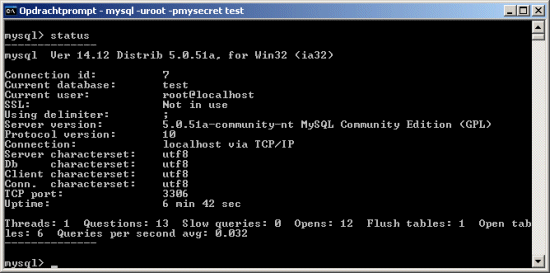
- The my.ini file used is located in the C:\Tools\mysql directory. This file looks like:
# MySQL Server Instance Configuration File
# ----------------------------------------------------------------------
# Generated by the MySQL Server Instance Configuration Wizard
#
#
# Installation Instructions
# ----------------------------------------------------------------------
#
# On Linux you can copy this file to /etc/my.cnf to set global options,
# mysql-data-dir/my.cnf to set server-specific options
# (@localstatedir@ for this installation) or to
# ~/.my.cnf to set user-specific options.
#
# On Windows you should keep this file in the installation directory
# of your server (e.g. C:\Program Files\MySQL\MySQL Server X.Y). To
# make sure the server reads the config file use the startup option
# "--defaults-file".
#
# To run run the server from the command line, execute this in a
# command line shell, e.g.
# mysqld --defaults-file="C:\Program Files\MySQL\MySQL Server X.Y\my.ini"
#
# To install the server as a Windows service manually, execute this in a
# command line shell, e.g.
# mysqld --install MySQLXY --defaults-file="C:\Program Files\MySQL\
# MySQL Server X.Y\my.ini"
#
# And then execute this in a command line shell to start the server, e.g.
# net start MySQLXY
#
#
# Guildlines for editing this file
# ----------------------------------------------------------------------
#
# In this file, you can use all long options that the program supports.
# If you want to know the options a program supports, start the program
# with the "--help" option.
#
# More detailed information about the individual options can also be
# found in the manual.
#
#
# CLIENT SECTION
# ----------------------------------------------------------------------
#
# The following options will be read by MySQL client applications.
# Note that only client applications shipped by MySQL are guaranteed
# to read this section. If you want your own MySQL client program to
# honor these values, you need to specify it as an option during the
# MySQL client library initialization.
#
[client]
port=3306
[mysql]
default-character-set=utf8
# SERVER SECTION
# ----------------------------------------------------------------------
#
# The following options will be read by the MySQL Server. Make sure than
# you have installed the server correctly (see above) so it reads this
# file.
#
[mysqld]
# The TCP/IP Port the MySQL Server will listen on
port=3306
#Path to installation directory. All paths are usually resolved relative to this.
basedir="C:/tools/MySQL/"
#Path to the database root
datadir="C:/tools/MySQL/Data/"
# The default character set that will be used when a new schema or table is
# created and no character set is defined
default-character-set=utf8
# The default storage engine that will be used when create new tables when
default-storage-engine=INNODB
# Set the SQL mode to strict
sql-mode="STRICT_TRANS_TABLES,NO_AUTO_CREATE_USER,NO_ENGINE_SUBSTITUTION"
# The maximum amount of concurrent sessions the MySQL server will
# allow. One of these connections will be reserved for a user with
# SUPER privileges to allow the administrator to login even if the
# connection limit has been reached.
max_connections=100
# Query cache is used to cache SELECT results and later return them
# without actual executing the same query once again. Having the query
# cache enabled may result in significant speed improvements, if your
# have a lot of identical queries and rarely changing tables. See the
# "Qcache_lowmem_prunes" status variable to check if the current value
# is high enough for your load.
# Note: In case your tables change very often or if your queries are
# textually different every time, the query cache may result in a
# slowdown instead of a performance improvement.
query_cache_size=0
# The number of open tables for all threads. Increasing this value
# increases the number of file descriptors that mysqld requires.
# Therefore you have to make sure to set the amount of open files
# allowed to at least 4096 in the variable "open-files-limit" in
# section [mysqld_safe]
table_cache=256
# Maximum size for internal (in-memory) temporary tables. If a table
# grows larger than this value, it is automatically converted to disk
# based table This limitation is for a single table. There can be many
# of them.
tmp_table_size=5M
# How many threads we should keep in a cache for reuse. When a client
# disconnects, the client's threads are put in the cache if there aren't
# more than thread_cache_size threads from before. This greatly reduces
# the amount of thread creations needed if you have a lot of new
# connections. (Normally this doesn't give a notable performance
# improvement if you have a good thread implementation.)
thread_cache_size=8
#*** MyISAM Specific options
# The maximum size of the temporary file MySQL is allowed to use while
# recreating the index (during REPAIR, ALTER TABLE or LOAD DATA INFILE.
# If the file-size would be bigger than this, the index will be created
# through the key cache (which is slower).
myisam_max_sort_file_size=100G
# If the temporary file used for fast index creation would be bigger
# than using the key cache by the amount specified here, then prefer the
# key cache method. This is mainly used to force long character keys in
# large tables to use the slower key cache method to create the index.
myisam_max_extra_sort_file_size=100G
# If the temporary file used for fast index creation would be bigger
# than using the key cache by the amount specified here, then prefer the
# key cache method. This is mainly used to force long character keys in
# large tables to use the slower key cache method to create the index.
myisam_sort_buffer_size=8M
# Size of the Key Buffer, used to cache index blocks for MyISAM tables.
# Do not set it larger than 30% of your available memory, as some memory
# is also required by the OS to cache rows. Even if you're not using
# MyISAM tables, you should still set it to 8-64M as it will also be
# used for internal temporary disk tables.
key_buffer_size=8M
# Size of the buffer used for doing full table scans of MyISAM tables.
# Allocated per thread, if a full scan is needed.
read_buffer_size=64K
read_rnd_buffer_size=256K
# This buffer is allocated when MySQL needs to rebuild the index in
# REPAIR, OPTIMZE, ALTER table statements as well as in LOAD DATA INFILE
# into an empty table. It is allocated per thread so be careful with
# large settings.
sort_buffer_size=212K
#*** INNODB Specific options ***
# Use this option if you have a MySQL server with InnoDB support enabled
# but you do not plan to use it. This will save memory and disk space
# and speed up some things.
#skip-innodb
# Additional memory pool that is used by InnoDB to store metadata
# information. If InnoDB requires more memory for this purpose it will
# start to allocate it from the OS. As this is fast enough on most
# recent operating systems, you normally do not need to change this
# value. SHOW INNODB STATUS will display the current amount used.
innodb_additional_mem_pool_size=2M
# If set to 1, InnoDB will flush (fsync) the transaction logs to the
# disk at each commit, which offers full ACID behavior. If you are
# willing to compromise this safety, and you are running small
# transactions, you may set this to 0 or 2 to reduce disk I/O to the
# logs. Value 0 means that the log is only written to the log file and
# the log file flushed to disk approximately once per second. Value 2
# means the log is written to the log file at each commit, but the log
# file is only flushed to disk approximately once per second.
innodb_flush_log_at_trx_commit=1
# The size of the buffer InnoDB uses for buffering log data. As soon as
# it is full, InnoDB will have to flush it to disk. As it is flushed
# once per second anyway, it does not make sense to have it very large
# (even with long transactions).
innodb_log_buffer_size=1M
# InnoDB, unlike MyISAM, uses a buffer pool to cache both indexes and
# row data. The bigger you set this the less disk I/O is needed to
# access data in tables. On a dedicated database server you may set this
# parameter up to 80% of the machine physical memory size. Do not set it
# too large, though, because competition of the physical memory may
# cause paging in the operating system. Note that on 32bit systems you
# might be limited to 2-3.5G of user level memory per process, so do not
# set it too high.
innodb_buffer_pool_size=8M
# Size of each log file in a log group. You should set the combined size
# of log files to about 25%-100% of your buffer pool size to avoid
# unneeded buffer pool flush activity on log file overwrite. However,
# note that a larger logfile size will increase the time needed for the
# recovery process.
innodb_log_file_size=10M
# Number of threads allowed inside the InnoDB kernel. The optimal value
# depends highly on the application, hardware as well as the OS
# scheduler properties. A too high value may lead to thread thrashing.
innodb_thread_concurrency=8
- Check if you can create a database mobilefishdb, type:
mysql> create database mobilefishdb;
mysql> use mobilefishdb;
- Check if you can create a USER table, type:
mysql>create table user (
-> userid int auto_increment,
-> username varchar(255) not null,
-> firstname varchar(255) not null,
-> lastname varchar(255) not null,
-> title varchar(255) null,
-> gender enum('m', 'f') null,
-> date_of_birth date null,
-> password varchar(255) not null,
-> email varchar(255) not null,
-> phone varchar(255) null,
-> primary key (userid)
->);
- Check if you can delete the database mobilefishdb, type:
mysql> drop database mobilefishdb;
mysql> quit
- If you have previously removed "ZoneAlarm Free Firewall"
you can now reinstall it again.
- If you use the PEAR MDB2 package to access the MySQL database, use the
Example 1 script
to test if you can access the USER table.
If you get the following error message when running the script:
Client does not support authentication protocol requested by server; consider upgrading MySQL client
..it is caused by the MySql server >= 4.1 upgrade.
The latest versions of MySql uses a new format for the password (it's a longer hash).
In order for old clients to continue to use the newer server, you have to set the passwords on
the server to their old format or upgrade your client. Because upgrading the client can sometimes
be a pain, it's often easier to just update the passwords to the old format on the server.
Here are the steps how it is done:
- C:\Tools\mysql\bin>mysql -uroot -pmysecret
- mysql>update mysql.user set password=old_password('mysecret') where
-> host='localhost' and user='root';
- flush privileges;
If you run the script again the error message should not be displayed.
- The WinMySQLadmin.exe is not installed in the bin directoy. It is no longer supported/distributed.
Use MySQL GUI Tools Bundle for 5.0 instead. It includes the following products.
- MySQL Administrator 1.2 Generally Available
- MySQL Query Browser 1.2 Generally Available
- MySQL Migration Toolkit 1.1 Generally Available
|























